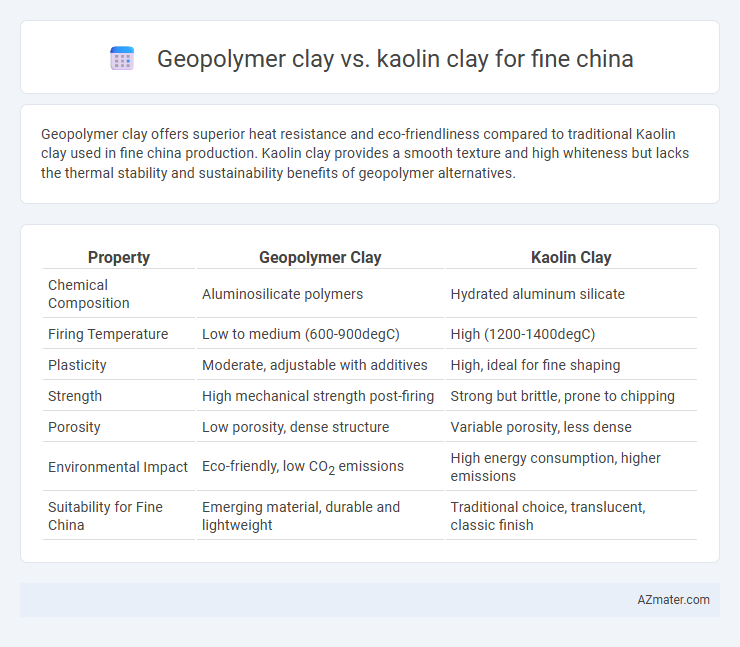Geopolymer clay offers superior heat resistance and eco-friendliness compared to traditional Kaolin clay used in fine china production. Kaolin clay provides a smooth texture and high whiteness but lacks the thermal stability and sustainability benefits of geopolymer alternatives.
Table of Comparison
| Property | Geopolymer Clay | Kaolin Clay |
|---|---|---|
| Chemical Composition | Aluminosilicate polymers | Hydrated aluminum silicate |
| Firing Temperature | Low to medium (600-900degC) | High (1200-1400degC) |
| Plasticity | Moderate, adjustable with additives | High, ideal for fine shaping |
| Strength | High mechanical strength post-firing | Strong but brittle, prone to chipping |
| Porosity | Low porosity, dense structure | Variable porosity, less dense |
| Environmental Impact | Eco-friendly, low CO2 emissions | High energy consumption, higher emissions |
| Suitability for Fine China | Emerging material, durable and lightweight | Traditional choice, translucent, classic finish |
Introduction to Geopolymer Clay and Kaolin Clay
Geopolymer clay is an innovative material composed of aluminosilicate minerals activated by alkaline solutions, offering high thermal stability and eco-friendly properties. Kaolin clay, a naturally occurring white clay rich in the mineral kaolinite, is traditionally used in fine china for its plasticity and purity, enabling smooth, durable porcelain finishes. Comparing the two, geopolymer clay introduces improved mechanical strength and fire resistance, whereas kaolin clay remains valued for its translucency and classic ceramic qualities.
Defining Fine China: Material Requirements
Fine china requires materials with high whiteness, translucency, and thermal resistance to withstand kiln firing and daily use. Geopolymer clay, with its aluminosilicate base, offers enhanced thermal stability and mechanical strength but lacks the natural translucency and smooth texture of kaolin clay. Kaolin clay, rich in pure white kaolinite mineral, is preferred for fine china due to its exceptional whiteness, plasticity, and ability to produce a delicate, translucent finish ideal for high-quality porcelain.
Composition and Chemical Structure
Geopolymer clay primarily consists of aluminosilicate materials activated by alkaline solutions, forming a three-dimensional polymer network with high thermal stability and mechanical strength. Kaolin clay, a natural hydrous aluminum silicate mineral (Al2Si2O5(OH)4), features plate-like particles with a layered silicate structure, providing excellent plasticity and whiteness essential for fine china. The chemical structure of geopolymers offers enhanced resistance to heat and chemicals, while kaolin's crystalline structure contributes to translucency and smoothness in fine china products.
Formation and Processing Techniques
Geopolymer clay, formed through the polymerization of aluminosilicate minerals with alkaline activators, offers a low-temperature setting process contrasting with kaolin clay's natural deposition and mining from kaolinite-rich soils. Kaolin clay requires extensive purification and calcination to enhance its whiteness and plasticity for fine china production, while geopolymer clay involves precise chemical activation and curing, reducing energy consumption. The processing techniques for kaolin emphasize particle size refinement and controlled drying, whereas geopolymer clay formation relies on geopolymerization chemistry to achieve desired hardness and translucency in fine china.
Physical Properties Comparison
Geopolymer clay exhibits superior thermal stability and higher mechanical strength compared to Kaolin clay, making it more resistant to cracking and deformation during firing. Kaolin clay, primarily composed of hydrous aluminum silicate, offers exceptional whiteness and translucency but has lower firing temperature tolerance and reduced flexural strength. The denser microstructure of geopolymer clay contributes to enhanced durability and lower porosity in fine china applications, whereas Kaolin clay is favored for its smooth texture and traditional aesthetic quality.
Aesthetic Qualities: Color, Texture, and Finish
Geopolymer clay offers a modern, customizable aesthetic with a smooth, matte finish and the ability to incorporate various pigments, resulting in diverse color options that enhance fine china's visual appeal. Kaolin clay, traditionally used in fine china, provides a pure white color, a smooth texture, and a glossy finish after firing, which are highly valued for their classic and elegant appearance. The choice between geopolymer and kaolin clay influences the final product's surface brilliance, translucency, and overall refined look, with kaolin being preferred for traditional fine china aesthetics.
Durability and Strength in Fine China Applications
Geopolymer clay exhibits superior durability and enhanced strength compared to kaolin clay in fine china applications due to its inorganic polymer matrix, which provides higher resistance to thermal shock and mechanical stress. Kaolin clay, traditionally used for fine china, offers excellent whiteness and plasticity but demonstrates lower tensile strength and is more susceptible to cracking under high thermal gradients. The geopolymer matrix's chemical bonding allows fine china to achieve improved longevity and structural integrity, making it a preferable choice for advanced ceramic manufacturing.
Environmental Impact and Sustainability
Geopolymer clay significantly reduces carbon emissions compared to kaolin clay, as it utilizes industrial byproducts like fly ash and slag, decreasing reliance on natural clay mining. Kaolin extraction involves high energy consumption and habitat disruption, whereas geopolymer clay production promotes waste valorization and lowers overall environmental footprint. Sustainable applications in fine china favor geopolymer clay for its potential to minimize resource depletion and enhance circular economy practices in ceramics manufacturing.
Cost and Availability Factors
Geopolymer clay offers a cost-effective alternative to traditional kaolin clay for fine china production due to its lower raw material expenses and widespread availability from byproducts like fly ash and metakaolin. Kaolin clay, while prized for its purity and whiteness, tends to be more expensive and regionally limited, impacting large-scale manufacturing costs and supply consistency. Manufacturers seeking to reduce production costs and reliance on scarce natural resources increasingly favor geopolymer clay for its economic advantages and growing accessibility.
Future Trends in Fine China Material Choices
Geopolymer clay is emerging as a sustainable alternative to traditional Kaolin clay for fine china manufacturing, offering enhanced durability and reduced environmental impact due to its lower energy consumption during production. Innovations in geopolymer technology enable customization of thermal and mechanical properties, strengthening its appeal in modern ceramic art and industrial applications. Future trends indicate a gradual shift towards geopolymer clay driven by increasing regulatory pressure on mining activities and growing consumer demand for eco-friendly fine china products.

Infographic: Geopolymer clay vs Kaolin clay for Fine china
 azmater.com
azmater.com